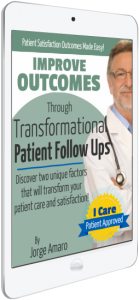Improve Outcomes through Transformational Follow Ups!
Our healthcare system is known for its complexity, demanding from each care participant hypervigilance over the smallest of details. A provider’s payment is dependent on getting these upfront details right, i.e., correct coding, correct notes, completed forms, timely filing, etc. Physician offices and hospitals deploy the vast majority of their resources for the infrastructure required to correctly capture pre-operative and perioperative details. Gathering, among others, benefit verification, prior authorizations, pre-determinations, and informed consent requires upfront and ongoing energy that is perpetuated by multiple regulations. The cycle spins and spins again simply because the demand for services continues to grow.
Most patients that enter this cycle simply want to get out as soon as possible. Yet the process for gracefully exiting this system, i.e., post-op follow-up, attracts the least amount of resources. Of course providers care about patients getting better and yes, providers often lose visibility to a patient’s progress once they leave the doctor’s office or hospital. The systems in place to perform patient follow up’s once the patient leaves the doctor’s office or hospital are often inadequate to break through the barriers that day-to-day life introduces such as a phone number change, and address change or a preference for emails. Unfortunately, the emergency room and readmissions then serve as the opportunity to retrospectively collect valuable post-op follow-up data that could have prevented the emergency room visit or readmission in the first place.
Patient follow-up is the right thing to do. Doing so will ensure that you are seen as patient-centric, reinforces other positive experiences, leads to improved adherence to post hospitalization, procedure or office visit protocols and better clinical and patient satisfaction outcomes. When a provider contacts the patient they are saying out loud what every patient wants to hear; “I Care.”
As outcome-based reimbursement strategies become more prevalent the provider will need to add focus to more effective follow-up strategies. History tells us that eventually government will increase regulation and health plans will increase requirements for patient follow up protocols; simply look at HIPAA, HEDIS, and PQRS as a few examples. Therefore, it is imperative that providers leverage a strong system for patient follow up to gather the data required. Strong patient follow up systems will significantly increase the probability when timely follow up connection occurs. The system must be metric based, flexible to handle multiple follow up protocols, and easy for the provider and patient to use. Beyond strength, the system must be mature. Two unique factors designed to assure the efficacy in a mature patient follow up platform are Resiliency and Trust.
This paper sets out to highlight these two significant factors that, when combined and systematically applied, will transform how patient follow-up is performed. This resource is available to you free of cost.


